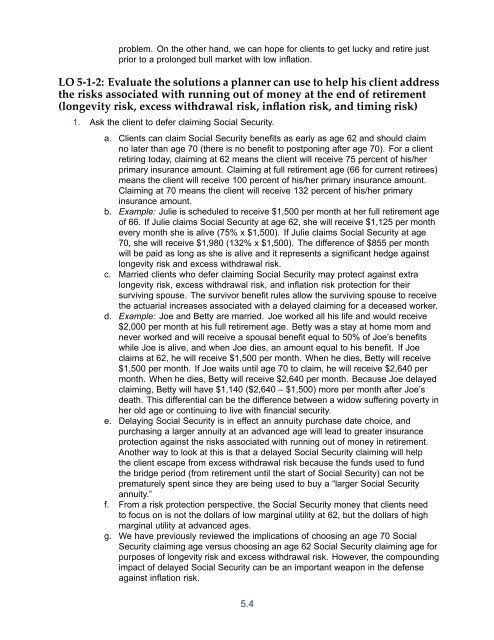section 1 - The American College Online Learning Center
section 1 - The American College Online Learning Center
section 1 - The American College Online Learning Center
Create successful ePaper yourself
Turn your PDF publications into a flip-book with our unique Google optimized e-Paper software.
problem. On the other hand, we can hope for clients to get lucky and retire justprior to a prolonged bull market with low inflation.LO 5-1-2: Evaluate the solutions a planner can use to help his client addressthe risks associated with running out of money at the end of retirement(longevity risk, excess withdrawal risk, inflation risk, and timing risk)1. Ask the client to defer claiming Social Security.a. Clients can claim Social Security benefits as early as age 62 and should claimno later than age 70 (there is no benefit to postponing after age 70). For a clientretiring today, claiming at 62 means the client will receive 75 percent of his/herprimary insurance amount. Claiming at full retirement age (66 for current retirees)means the client will receive 100 percent of his/her primary insurance amount.Claiming at 70 means the client will receive 132 percent of his/her primaryinsurance amount.b. Example: Julie is scheduled to receive $1,500 per month at her full retirement ageof 66. If Julie claims Social Security at age 62, she will receive $1,125 per monthevery month she is alive (75% x $1,500). If Julie claims Social Security at age70, she will receive $1,980 (132% x $1,500). <strong>The</strong> difference of $855 per monthwill be paid as long as she is alive and it represents a significant hedge againstlongevity risk and excess withdrawal risk.c. Married clients who defer claiming Social Security may protect against extralongevity risk, excess withdrawal risk, and inflation risk protection for theirsurviving spouse. <strong>The</strong> survivor benefit rules allow the surviving spouse to receivethe actuarial increases associated with a delayed claiming for a deceased worker.d. Example: Joe and Betty are married. Joe worked all his life and would receive$2,000 per month at his full retirement age. Betty was a stay at home mom andnever worked and will receive a spousal benefit equal to 50% of Joe’s benefitswhile Joe is alive, and when Joe dies, an amount equal to his benefit. If Joeclaims at 62, he will receive $1,500 per month. When he dies, Betty will receive$1,500 per month. If Joe waits until age 70 to claim, he will receive $2,640 permonth. When he dies, Betty will receive $2,640 per month. Because Joe delayedclaiming, Betty will have $1,140 ($2,640 – $1,500) more per month after Joe’sdeath. This differential can be the difference between a widow suffering poverty inher old age or continuing to live with financial security.e. Delaying Social Security is in effect an annuity purchase date choice, andpurchasing a larger annuity at an advanced age will lead to greater insuranceprotection against the risks associated with running out of money in retirement.Another way to look at this is that a delayed Social Security claiming will helpthe client escape from excess withdrawal risk because the funds used to fundthe bridge period (from retirement until the start of Social Security) can not beprematurely spent since they are being used to buy a “larger Social Securityannuity.”f. From a risk protection perspective, the Social Security money that clients needto focus on is not the dollars of low marginal utility at 62, but the dollars of highmarginal utility at advanced ages.g. We have previously reviewed the implications of choosing an age 70 SocialSecurity claiming age versus choosing an age 62 Social Security claiming age forpurposes of longevity risk and excess withdrawal risk. However, the compoundingimpact of delayed Social Security can be an important weapon in the defenseagainst inflation risk.5.4
















